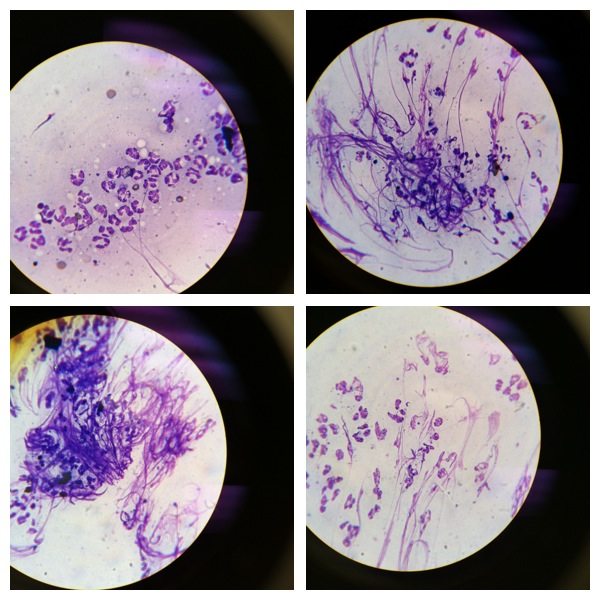Is your pet scratching its ears? It might be time for a trip to the ear doctor.
When a pet's ears are bothersome, head shaking and ear scratching can keep both you and the animal up all night. Ear troubles should be addressed promptly to prevent aural hematomas (blood-filled pockets in the ears) as well as further infestation.
Ear infections in animals are typically caused by bacteria or fungi. However, ear mites can also cause complications.
With the exception of an ear mite check, a glass slide with an ear smear is stained before microscopic observation to determine whether the bacteria are gram-positive (blue/purple) or gram-negative (pink).
1. Cocci Bacteria
Under the microscope, cocci resemble perfectly round balls. They are often found in clusters or chains. Diplococci is characterized by two adjacent cocci and should be noted in analysis.
Few lone, individual dots on a slide could be mistaken for cocci when they are, in fact, merely cellular debris. However, a trained laboratory technician could readily note the difference.

Stacey Venzel
2. Rod Bacteria
Small sticks in a stained ear sample are classified as rod bacteria. Similar to cocci, they are often found in clumps or chains.
3. Yeast
A type of fungi, yeast typically resemble purple pills or cigars when stained under the microscope. Though elongated, they are significantly rounder and larger than rods. Budding yeast—meaning yeast that is growing or splitting—will look just like a snowman.
4. Ear Mites
This analysis is done without a stain or firing of the slide. Instead, a drop of immersion oil is placed over the sample and observed under the highest magnification for these insects, readily noticeable with their appendages.
They resemble fleas in their appearance.
5. White Blood Cells (WBCs)
The presence of white blood cells indicates a severe inflammation and infection. The types of WBCs are typically identifiable under the microscope as well, which can be helpful in determining the bacterial progression as well as the degree or type of inflammation.
Eosinophils, for example, often indicate an allergic reaction, parasitic reaction, or cancer. Sometimes, the WBCs will be smeared across the slide in a very artistic fashion referred to as neutrophilic streaming.
Additional findings in ear samples include epithelial (skin) cells or ceruminous material otherwise known as waxy debris. While these should be noted in the analysis, the aforementioned findings are of the most clinical significance.
Medications including ear wash and enzymatic ointment, or antibiotics might be necessary. Antibiotics do not kill fungi, so a pet with only yeast present in its ears won't be cured with antibiotics. However, both yeast and bacteria can be present, in which case antibiotics would likely be prescribed.
Holistic medicine has also seen results with treating ear infections and hematomas naturally, using herbs instead of Western drugs or surgical ear draining.
Ear infections often occur in moist ears; dogs who spend a lot of time in the water are especially prone. Breeds with longer, floppier ears are also more susceptible to infections due to viable pockets created by the natural shape of the ear. Consistent cleaning can help prevent these sorts of infection.
Do you know which type of ear infection your pet has had? Tell us in the comments below.
WATCH NOW: WHY PETS ARE THE BEST




